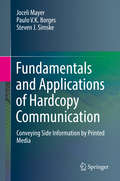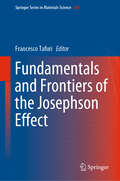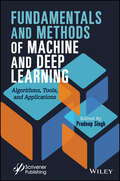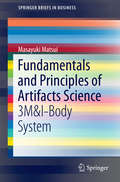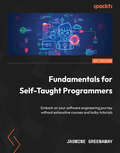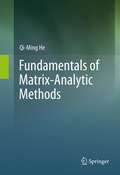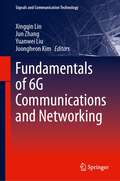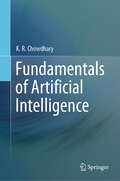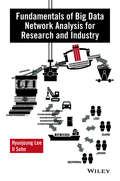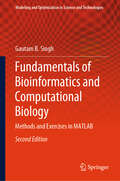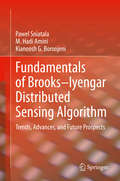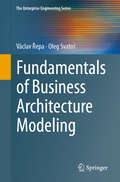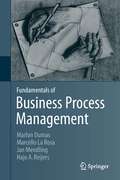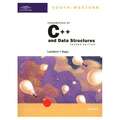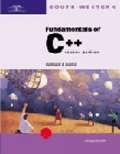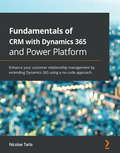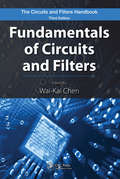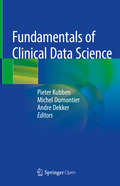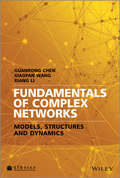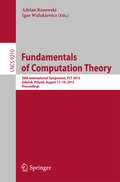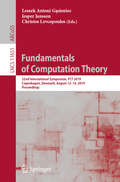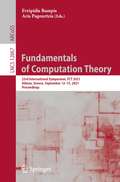- Table View
- List View
Fundamentals and Applications of Hardcopy Communication: Conveying Side Information By Printed Media
by Steven J. Simske Joceli Mayer Paulo V.K. BorgesThis book presents covert, semi-covert and overt techniques for communication over printed media by modifying images, texts or barcodes within the document. Basic and advanced techniques are discussed aimed to modulate information into images, texts and barcodes.Conveying information over printed media can be useful for content authentication, author copyright, information and piracy product deterrent, side information for marketing, among other applications. Practical issues are discussed and experiments are provided to evaluate competitive approaches for hard-copy communication.This book is a useful resource for researchers, practitioners and graduate students in the field of hard-copy communication by providing the fundamentals, basic and advanced techniques as examples of approaches to address the hard-copy media distortions and particularities.
Fundamentals and Frontiers of the Josephson Effect (Springer Series in Materials Science #286)
by Francesco TafuriThis book provides a comprehensive and up-to-date description of the Josephson effect, a topic of never-ending interest in both fundamental and applied physics. In this volume, world-renowned experts present the unique aspects of the physics of the Josephson effect, resulting from the use of new materials, of hybrid architectures and from the possibility of realizing nanoscale junctions. These new experimental capabilities lead to systems where novel coherent phenomena and transport processes emerge. All this is of great relevance and impact, especially when combined with the didactic approach of the book. The reader will benefit from a general and modern view of coherent phenomena in weakly-coupled superconductors on a macroscopic scale. Topics that have been only recently discussed in specialized papers and in short reviews are described here for the first time and organized in a general framework. An important section of the book is also devoted to applications, with focus on long-term, future applications. In addition to a significant number of illustrations, the book includes numerous tables for comparative studies on technical aspects.
Fundamentals and Methods of Machine and Deep Learning: Algorithms, Tools, and Applications
by Pradeep SinghFUNDAMENTALS AND METHODS OF MACHINE AND DEEP LEARNING The book provides a practical approach by explaining the concepts of machine learning and deep learning algorithms, evaluation of methodology advances, and algorithm demonstrations with applications. Over the past two decades, the field of machine learning and its subfield deep learning have played a main role in software applications development. Also, in recent research studies, they are regarded as one of the disruptive technologies that will transform our future life, business, and the global economy. The recent explosion of digital data in a wide variety of domains, including science, engineering, Internet of Things, biomedical, healthcare, and many business sectors, has declared the era of big data, which cannot be analysed by classical statistics but by the more modern, robust machine learning and deep learning techniques. Since machine learning learns from data rather than by programming hard-coded decision rules, an attempt is being made to use machine learning to make computers that are able to solve problems like human experts in the field. The goal of this book is to present a??practical approach by explaining the concepts of machine learning and deep learning algorithms with applications. Supervised machine learning algorithms, ensemble machine learning algorithms, feature selection, deep learning techniques, and their applications are discussed. Also included in the eighteen chapters is unique information which provides a clear understanding of concepts by using algorithms and case studies illustrated with applications of machine learning and deep learning in different domains, including disease prediction, software defect prediction, online television analysis, medical image processing, etc. Each of the chapters briefly described below provides both a chosen approach and its implementation. Audience Researchers and engineers in artificial intelligence, computer scientists as well as software developers.
Fundamentals and Principles of Artifacts Science
by Masayuki MatsuiThis is the first book covering original information on the mathematical science of such the artifacts as 3M&I-body system, in which "3M" means human, material/machine, money, and "I" means the information/method in nature versus artifacts. This book is the product of industrial engineering versus Wiener's cybernetics challenge for a half-century. For 3M&I-body, there are two approaches of artificial intelligence/IoT (internet of things) and Matsui's matrix/3D to systemization and control. The former is the analogical and visual approach to real entity. The latter is the digital and logical approach to system decision and is applied to the robotics of bodies. The mathematical science of a body is well constructed from the algebra, geometry, analysis, and control on Matsui's equation, toward the sandwich and balancing propositions of bodies. The sandwich issues propose the squeeze or pinching theorem in mathematics at the 3M&I-body, and the balancing issues propose the principle of balancing and invisible collaboration of bodies, beginning from the work of Archimedes. This book contributes to the integration of knowledge and intelligence in science and facilitate the realization of the cyber/real-world , such as the enterprise robot, cloud-coordinated supply-chain management (SCM), and smart cities in the near future.
Fundamentals for Self-Taught Programmers: Embark on your software engineering journey without exhaustive courses and bulky tutorials
by Jasmine GreenawayAn absolute beginner's guide to strengthening the fundamentals before learning your first programming languagePurchase of the print or Kindle book includes a free PDF eBookKey FeaturesExplore fundamental computer science concepts from data structures through to object-oriented programmingProgress from understanding the software engineering landscape to writing your first programAuthored by a Microsoft community insider and filled with case studies from software engineering rolesBook DescriptionSoftware engineering is a set of techniques, including programming, within the computer science discipline associated with the development of software products. This practical guide to software engineering will enable aspiring and new developers to satisfy their curiosity about the industry and become ready to learn more about the basics before beginning to explore programming languages, along with helping junior and upcoming developers to effectively apply their knowledge in the field. The book begins by providing you with a comprehensive introduction to software engineering, helping you gain a clear, holistic understanding of its various sub-fields. As you advance, you'll get to grips with the fundamentals of software engineering, such as flow control, data structures and algorithms. The book also introduces you to C# and guides you in writing your first program. The concluding chapters will cover case studies, including people working in the industry in different engineering roles, as well as interview tips and tricks and coding best practices. By the end of this programming book, you'll have gained practical knowledge of the implementation and associated methodologies in programming that will have you up and running and productive in no time.What you will learnGain an understanding of the software engineering landscapeGet up and running with fundamental programming concepts in C#Implement object-oriented programming (OOP) in C#Gain insights on how to keep the code readable and reusableDiscover various tips and tricks to efficiently prepare for a software engineering interviewImplement various popular algorithms using C#Who this book is forThis book is for anyone who is curious about programming and interested in entering the field of software engineering by beginning at the fundamentals. No prior knowledge of computer science or software engineering is necessary.
Fundamentals in Assistive Technology 4th Edition
by Michelle L. LangeAn Introduction to Assistive Technology Implementation in the Lives of People with Disabilities
Fundamentals of Matrix-Analytic Methods
by Qi-Ming HeFundamentals of Matrix-Analytic Methods targets advanced-level students in mathematics, engineering and computer science. It focuses on the fundamental parts of Matrix-Analytic Methods, Phase-Type Distributions, Markovian arrival processes and Structured Markov chains and matrix geometric solutions. New materials and techniques are presented for the first time in research and engineering design. This book emphasizes stochastic modeling by offering probabilistic interpretation and constructive proofs for Matrix-Analytic Methods. Such an approach is especially useful for engineering analysis and design. Exercises and examples are provided throughout the book.
Fundamentals of 6G Communications and Networking (Signals and Communication Technology)
by Jun Zhang Yuanwei Liu Xingqin Lin Joongheon KimThis book begins with a historical overview of the evolution of mobile technologies and addresses two key questions: why do we need 6G? and what will 6G be? The remaining chapters of this book are organized into three parts: Part I covers the foundation of an end-to-end 6G system by presenting 6G vision, driving forces, key performance indicators, and societal requirements on digital inclusion, sustainability, and intelligence. Part II presents key radio technology components for the 6G communications to deliver extreme performance, including new radio access technologies at high frequencies, joint communications and sensing, AI-driven air interface, among others. Part III describes key enablers for intelligent 6G networking, including network disaggregation, edge computing, data-driven management and orchestration, network security and trustworthiness, among others. This book is relevant to researchers, professionals, and academics working in 5G/6G and beyond.
Fundamentals of Artificial Intelligence
by K.R. ChowdharyFundamentals of Artificial Intelligence introduces the foundations of present day AI and provides coverage to recent developments in AI such as Constraint Satisfaction Problems, Adversarial Search and Game Theory, Statistical Learning Theory, Automated Planning, Intelligent Agents, Information Retrieval, Natural Language & Speech Processing, and Machine Vision. The book features a wealth of examples and illustrations, and practical approaches along with the theoretical concepts. It covers all major areas of AI in the domain of recent developments. The book is intended primarily for students who major in computer science at undergraduate and graduate level but will also be of interest as a foundation to researchers in the area of AI.
Fundamentals of Automotive Structures and Battery Electric Vehicle Applications (Synthesis Lectures on Mechanical Engineering)
by Mark DingmanThis book covers three topics; 1) automotive structure foundational information, 2) the physics of important loading conditions & how they influence the structure’s design, and 3) how the physics & design implications are different for the Battery Electric Vehicle (BEV) configuration. Currently, the automotive industry is desperately trying to develop cost competitive BEVs, with mixed success. The underlying engineering principles that enable efficient BEV structure are not well known within the industry and this book will provide that critical information to those seasoned automotive engineers. In many companies, a large portion of those seasoned engineers are nearing retirement and a new generation will be entering the workforce. Many companies are looking for ways to avoid the resulting knowledge loss and this book also addresses that; providing the information needed to quickly bring new engineers up to speed.
Fundamentals of Big Data Network Analysis for Research and Industry
by Hyunjoung Lee Il SohnFundamentals of Big Data Network Analysis for Research and Industry Hyunjoung Lee, Institute of Green Technology, Yonsei University, Republic of Korea Il Sohn, Material Science and Engineering, Yonsei University, Republic of Korea Presents the methodology of big data analysis using examples from research and industry There are large amounts of data everywhere, and the ability to pick out crucial information is increasingly important. Contrary to popular belief, not all information is useful; big data network analysis assumes that data is not only large, but also meaningful, and this book focuses on the fundamental techniques required to extract essential information from vast datasets. Featuring case studies drawn largely from the iron and steel industries, this book offers practical guidance which will enable readers to easily understand big data network analysis. Particular attention is paid to the methodology of network analysis, offering information on the method of data collection, on research design and analysis, and on the interpretation of results. A variety of programs including UCINET, NetMiner, R, NodeXL, and Gephi for network analysis are covered in detail. Fundamentals of Big Data Network Analysis for Research and Industry looks at big data from a fresh perspective, and provides a new approach to data analysis. This book: Explains the basic concepts in understanding big data and filtering meaningful data Presents big data analysis within the networking perspective Features methodology applicable to research and industry Describes in detail the social relationship between big data and its implications Provides insight into identifying patterns and relationships between seemingly unrelated big data Fundamentals of Big Data Network Analysis for Research and Industry will prove a valuable resource for analysts, research engineers, industrial engineers, marketing professionals, and any individuals dealing with accumulated large data whose interest is to analyze and identify potential relationships among data sets.
Fundamentals of Bioinformatics and Computational Biology: Methods and Exercises in MATLAB (Modeling and Optimization in Science and Technologies #19)
by Gautam B. SinghThis book comprehensively covers all the core bioinformatics topics and includes practical examples completed using the MATLAB bioinformatics and machine learning toolboxes™. It is primarily intended as a textbook for engineering and computer science students attending advanced undergraduate and graduate courses in bioinformatics and computational biology. The book develops bioinformatics concepts from the ground up, starting with an introductory chapter on molecular biology and genetics to enable physical science students to appreciate the challenges in biological data management, sequence analysis, and systems biology. The book is divided into five parts. The first one includes a survey of existing biological databases and tools that have become essential in today’s biotechnology research. The second part covers methodologies for retrieving biological information, including fundamental algorithms for sequence comparison, scoring, and determining evolutionary distance. The third part of the book focuses on modeling biological sequences and patterns as Markov chains, covering core principles for analyzing and searching for sequences of significant motifs and biomarkers and developing stochastic ergodic hidden Markov models for biological sequence families. The fourth one is dedicated to systems biology and covers phylogenetic analysis and evolutionary tree computations, as well as gene expression analysis with microarrays. In turn, the last part of the book includes an introduction to machine-learning algorithms for bioinformatics and outlines strategies for developing intelligent diagnostic machine-learning applications, RNA sequence data, and deep learning systems for mass spectrometry data. All in all, this book offers a unique hands-on reference guide to bioinformatics and computational biology. This second edition has been updated to cover additional and most recent databases, and machine learning and deep learning applications in RNA sequence and mass-spectrometry data analysis. Moreover, it presents significant enhancements to the chapter dedicated to microarray analysis, and more practical examples, with additional end-of-chapter problems.
Fundamentals of Brooks–Iyengar Distributed Sensing Algorithm: Trends, Advances, and Future Prospects
by Kianoosh G. Boroojeni M. Hadi Amini Pawel SniatalaThis book provides a comprehensive analysis of Brooks-Iyengar Distributed Sensing Algorithm, which brings together the power of Byzantine Agreement and sensor fusion in building a fault-tolerant distributed sensor network. The authors analyze its long-term impacts, advances, and future prospects. The book starts by discussing the Brooks-Iyengar algorithm, which has made significant impact since its initial publication in 1996. The authors show how the technique has been applied in many domains such as software reliability, distributed systems and OS development, etc. The book exemplifies how the algorithm has enhanced new real-time features by adding fault-tolerant capabilities for many applications. The authors posit that the Brooks-Iyengar Algorithm will to continue to be used where fault-tolerant solutions are needed in redundancy system scenarios.This book celebrates S.S. Iyengar's accomplishments that led to his 2019 Institute of Electrical and Electronics Engineers' (IEEE) Cybermatics Congress "Test of Time Award" for his work on creating Brooks-Iyengar Algorithm and its impact in advancing modern computing.
Fundamentals of Business Architecture Modeling (The Enterprise Engineering Series)
by Václav Řepa Oleg SvatošThis textbook covers business architecture modeling in all its essential aspects. Based on the MMABP Philosophical Framework for Business System Modelling it provides a comprehensive overview of four basic dimensions of the business system model together with their essential relationships. The methods, techniques, and tools are described and explained for every model type with examples. Special attention is paid to integrating all dimensions using the Business System Consistency Framework. The book is divided into six chapters. Chapter 1 introduces business architecture and the approaches and tools to model it. MMABP is introduced with its basic principles and put in context with other approaches to business architecture modeling. Chapter 2 then deals with the modeling of a business system in terms of its objectives. The basic principles of process modeling, the distinction between global and detailed views of processes, and an approach to managing the detail of the process model in the form of four levels of process abstraction are introduced. Chapter 3 describes the modeling of a business system in terms of its underlying concepts and the business rules that apply within the modeled system. The basic principles of object modeling, the distinction between global and detailed views of objects, and the approach to capturing the object life cycles are introduced. Chapter 4 presents a simplified metamodel that describes how all models of the business system are related, and consistency rules that guide the analysts to avoid possible inconsistencies. Chapter 5 focuses on the implementation of the business system in an organization. It describes the role and specifics of its information system, explains the comprehensive procedure for building the process-driven organization, and reflects on the organizational maturity and its role in the further development of a process-driven organization. Eventually, Chapter 6 presents a complex example of the application of MMABP, including the functioning prototype of the process system. The prototype is then used to illustrate an essential difference between the conceptual and technology levels of models, and the importance of distinguishing between them. This textbook is written for students in enterprise architecture or business information systems as well as for professionals developing enterprise information systems or process-driven organizations.
Fundamentals of Business Process Management
by Marlon Dumas Hajo A. Reijers Jan Mendling Marcello La RosaBusiness Process Management (BPM) is the art and science of how work should be performed in an organization in order to ensure consistent outputs and to take advantage of improvement opportunities, e.g. reducing costs, execution times or error rates. Importantly, BPM is not about improving the way individual activities are performed, but rather about managing entire chains of events, activities and decisions that ultimately produce added value for an organization and its customers. This textbook encompasses the entire BPM lifecycle, from process identification to process monitoring, covering along the way process modelling, analysis, redesign and automation. Concepts, methods and tools from business management, computer science and industrial engineering are blended into one comprehensive and inter-disciplinary approach. The presentation is illustrated using the BPMN industry standard defined by the Object Management Group and widely endorsed by practitioners and vendors worldwide. In addition to explaining the relevant conceptual background, the book provides dozens of examples, more than 100 hands-on exercises - many with solutions - as well as numerous suggestions for further reading. The textbook is the result of many years of combined teaching experience of the authors, both at the undergraduate and graduate levels as well as in the context of professional training. Students and professionals from both business management and computer science will benefit from the step-by-step style of the textbook and its focus on fundamental concepts and proven methods. Lecturers will appreciate the class-tested format and the additional teaching material available on the accompanying website fundamentals-of-bpm.org.
Fundamentals of Business Process Management
by Marlon Dumas Hajo A. Reijers Jan Mendling Marcello La RosaBusiness Process Management (BPM) is the art and science of how work should be performed in an organization in order to ensure consistent outputs and to take advantage of improvement opportunities, e.g. reducing costs, execution times or error rates. Importantly, BPM is not about improving the way individual activities are performed, but rather about managing entire chains of events, activities and decisions that ultimately produce added value for an organization and its customers.This textbook encompasses the entire BPM lifecycle, from process identification to process monitoring, covering along the way process modelling, analysis, redesign and automation. Concepts, methods and tools from business management, computer science and industrial engineering are blended into one comprehensive and inter-disciplinary approach. The presentation is illustrated using the BPMN industry standard defined by the Object Management Group and widely endorsed by practitioners and vendors worldwide. In addition to explaining the relevant conceptual background, the book provides dozens of examples, more than 100 hands-on exercises – many with solutions – as well as numerous suggestions for further reading. The textbook is the result of many years of combined teaching experience of the authors, both at the undergraduate and graduate levels as well as in the context of professional training. Students and professionals from both business management and computer science will benefit from the step-by-step style of the textbook and its focus on fundamental concepts and proven methods. Lecturers will appreciate the class-tested format and the additional teaching material available on the accompanying website fundamentals-of-bpm.org.
Fundamentals of C++ and Data Structures, Advanced Course (2nd Edition)
by Kenneth Lambert Thomas NapsFollowing the success of Fundamentals of Program Design and Data Structures by Lambert and Naps, C++ Advanced Course is essential for a second course in Computer Science. Completely updated, this text provides in-depth coverage to help students prepare for the AP exam, Exam AB. A full introduction to the essential features of C++ is provided and programming techniques are emphasized in the context of interesting and realistic case problems. This text is compatible with C++ compilers from Microsoft, Borland, and Metrowerks.
Fundamentals of C++: Introductory Course (2nd Edition)
by Kenneth Lambert Douglas W. NanceFollowing the success of Fundamentals of C++ by Lambert and Nance, C++ Introductory course is essential for a first course in Computer Science. Completely updated, this text provides in-depth coverage to help students prepare for the AP exam, Exam A. A full introduction to the essential features of C++ is provided and programming techniques are emphasized in the context of interesting and realistic case problems. This text is compatible with C++ compilers from Microsoft, Borland, and Metrowerks.
Fundamentals of CRM with Dynamics 365 and Power Platform: Enhance your customer relationship management by extending Dynamics 365 using a no-code approach
by Nicolae TarlaExplore the latest features of Dynamics 365 and Power Platform's out-of-the-box tools to build custom business solutions for your organization Key Features Discover impressive Dynamics 365 features to transform your business and increase productivity Leverage the platform's extensibility to meet your organizational needs Understand how Power Platform powers Dynamics 365 and enhances its integration capabilities Book Description Microsoft Dynamics 365 provides a vast array of tools and applications to meet various Customer Engagement requirements. This Customer Relationship Management (CRM) guide covers the latest advancements in Dynamics 365 and Power Platform that help organizations adapt to changing market conditions for agility and resilience. With this book, you'll explore the core platform functionality of Dynamics 365 and explore its wide range of components for transforming your business with new services and capabilities. You'll learn the basics of configuration and customization to enhance the functionality of Microsoft Dynamics 365 CRM and create solutions and custom applications by leveraging features such as apps, portals, automation, and business intelligence. As you advance, you'll understand how Power Platform drives Dynamics 365 and how various integration capabilities add value by providing a comprehensive view of data aggregated across different systems and data sources. Finally, you'll delve into core administration concepts that will help you to manage extensions added to the platform. By the end of this book, you'll have learned how to tailor Microsoft Dynamics 365 to fit your organization's requirements and tweak the platform to meet your business needs. What you will learn Get to grips with Power Platform for building and enhancing Dynamics 365 apps Integrate Dynamics 365 CRM with Microsoft 365, Azure, and other platforms Discover how you can customize existing entities and create new ones Explore various security features and grant users access to CRM data and functions Find out which CRM attributes are used to automate operations with programming Use internal and external social data to help users to make informed decisions Who this book is for This book is for customers and project stakeholders, new functional consultants, business administration users, and project managers looking to get up and running with the latest features of Dynamics 365 and Power Platform. This guide will help non-developers become acquainted with a no-code approach to customization and configuration. A basic understanding of relational data and customer management concepts will help you get the most out of this book.
Fundamentals of Circuits and Filters (The Circuits and Filters Handbook, 3rd Edition)
by Wai-Kai ChenThis volume, drawn from the Circuits and Filters Handbook, focuses on mathematics basics; circuit elements, devices, and their models; and linear circuit analysis. It examines Laplace transformation, Fourier methods for signal analysis and processing, z-transform, and wavelet transforms. It also explores network laws and theorems, terminal and port represetnation, analysis in the frequency domain, and more.
Fundamentals of Clinical Data Science
by Pieter Kubben Michel Dumontier Andre DekkerThis open access book comprehensively covers the fundamentals of clinical data science, focusing on data collection, modelling and clinical applications. Topics covered in the first section on data collection include: data sources, data at scale (big data), data stewardship (FAIR data) and related privacy concerns. Aspects of predictive modelling using techniques such as classification, regression or clustering, and prediction model validation will be covered in the second section. The third section covers aspects of (mobile) clinical decision support systems, operational excellence and value-based healthcare. Fundamentals of Clinical Data Science is an essential resource for healthcare professionals and IT consultants intending to develop and refine their skills in personalized medicine, using solutions based on large datasets from electronic health records or telemonitoring programmes. The book’s promise is “no math, no code”and will explain the topics in a style that is optimized for a healthcare audience.
Fundamentals of Complex Networks: Models, Structures and Dynamics
by Guanrong Chen Xiang Li Xiaofan WangComplex networks such as the Internet, WWW, transportation networks, power grids, biological neural networks, and scientific cooperation networks of all kinds provide challenges for future technological development.• The first systematic presentation of dynamical evolving networks, with many up-to-date applications and homework projects to enhance study• The authors are all very active and well-known in the rapidly evolving field of complex networks• Complex networks are becoming an increasingly important area of research• Presented in a logical, constructive style, from basic through to complex, examining algorithms, through to construct networks and research challenges of the future
Fundamentals of Computation Theory
by Adrian Kosowski Igor WalukiewiczThis book constitutes the refereed proceedings of the 20th International Symposium on Fundamentals of Computation Theory, FCT 2015, held in Gdańsk, Poland, in August 2015. The 27 revised full papers presented were carefully reviewed and selected from 60 submissions. The papers cover topics in three main areas: algorithms, formal methods, and emerging fields and are organized in topical sections on geometry, combinatorics, text algorithms; complexity and Boolean functions; languages; set algorithms, covering, and traversal; graph algorithms and networking applications; anonymity and indistinguishability; graphs, automata, and dynamics; and logic and games.
Fundamentals of Computation Theory: 22nd International Symposium, FCT 2019, Copenhagen, Denmark, August 12-14, 2019, Proceedings (Lecture Notes in Computer Science #11651)
by Leszek Antoni Gąsieniec Jesper Jansson Christos LevcopoulosThis book constitutes the proceedings of the 22nd International Symposium on Fundamentals of Computation Theory, FCT 2019, held in Copenhagen, Denmark, in August 2019.The 21 full papers included in this volume were carefully reviewed and selected from 45 submissions. In addition, the book contains 3 invited talks in full-paper length. The papers were organized in topical sections named: formal methods, complexity, and algorithms.
Fundamentals of Computation Theory: 23rd International Symposium, FCT 2021, Athens, Greece, September 12–15, 2021, Proceedings (Lecture Notes in Computer Science #12867)
by Evripidis Bampis Aris PagourtzisThis book constitutes the proceedings of the 23rd International Symposium on Fundamentals of Computation Theory, FCT 2021, held in Athens, Greece, in September 2021. The 30 full papers included in this volume were carefully reviewed and selected from 94 submissions. In addition, the book contains 2 invited talks. The papers cover topics of all aspects of theoretical computer science, in particular algorithms, complexity, formal and logical methods.
